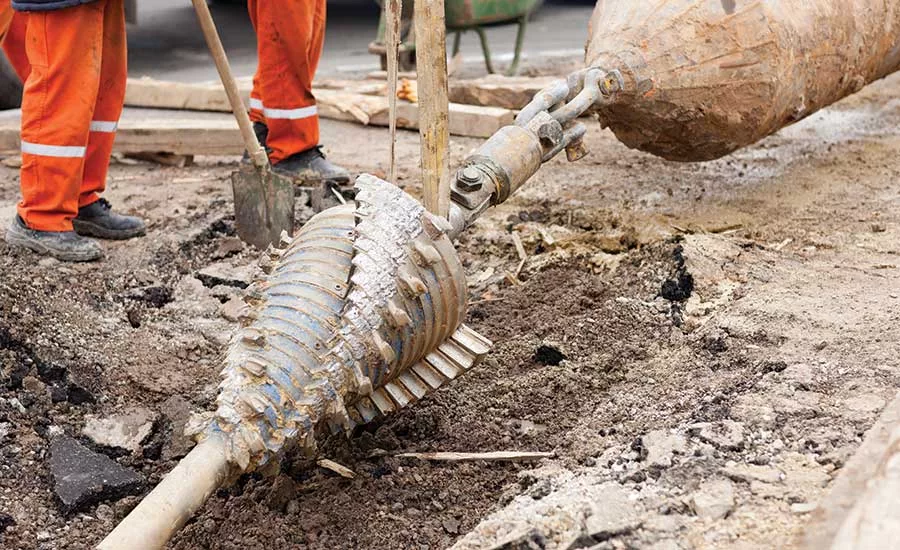How to Best Backream Through Shale


It’s always a good idea to talk to a fluid engineer to discuss ratios and viscosity before the job gets underway.
Shale is a layered mudrock that runs in ribbons through the earth. Though softer than many other types of rock, shale presents its own challenges during drilling. If you approach the shale at too shallow of an angle or use the wrong bit during a pilot shot, the drill is likely to glance off the surface and not penetrate the shale at all. During backreaming, the wrong choices can open up a whole new can of worms that can dramatically slow drilling progress or bring it to a halt. During our decades of providing HDD solutions for drillers working in every type of material, we’ve seen the strategies and tools that work for shale — and those that result in frustration and work stoppage. Here are a few proven tips to increase your speed and efficiency when backreaming through shale.
Know Your Conditions Before Backreaming
Every HDD job brings plenty of unknowns. The more attention you pay during your pilot shot, the more likely you are to be successful and productive during your backream. After shooting out the borehole, check the drill bit. Clumped-up material will give a sense of the shale’s softness and if you’ll need to use a reamer that can handle clay. Additionally, pay close attention to the material that is slurried out of the borehole. Clay will appear chunky or lumpy, instead of a nice, smooth texture that resembles soft serve ice cream or thinner. In cases where operators see clay, they should make sure to use a reamer that performs well in sticky conditions. If the shale stays hard during piloting, check the size of the cuttings. If they’re too big, further drilling will cause the reamer to struggle when slurring the chunks out of the hole. Cuttings will settle on the bottom of the hole then grab onto the backreamer, which can cause you to get stuck.
To Avoid Balling Up Fracture, Don’t Grind
Since shale is formed by layers of soft sediment, too much pulverizing can quickly over-grind the material, turning it into a powder. When that powder mixes with drilling fluid, operators run the risk of creating clay that can jam equipment. Choose reamers with lots of individual conical teeth on the cutting blade. These teeth act like picks, fracturing the shale and crushing it into smaller bits without reducing it to powder.
Find a Reamer That Can Handle Clay
Because of shale’s risk of reverting to clay-like conditions, if the pilot shot shows a very soft shale, it’s best to choose a reamer that performs well in clay. Make sure the reamer features the appropriate fluid mixing action to blend the shale cuttings, clay bits and drilling fluids without slowing down job progress.
In Harder Shale, Go for More Teeth or Use a PDC Reamer
Some shales are especially hard and respond like solid rock. In these cases, the more cutters the better. Additional cutters will provide more fracturing/pulverizing action so drillers won’t get stuck spinning in one place. In solid rock, use a hole opener or PDC reamer to do backreaming. Both types of these tools are designed for solid rock formations and can stand up to ultra-hard material.
Don’t Be Shy with Fluid Additives
Specialized drill fluid additives can go a long way toward preserving equipment and keeping operators from stopping the job to trip out. Polymer additives combat clumping in the material itself. Detergent additives coat the backreamer to make it harder for clay particles to stick to the cutting blades, reducing the risk of the material getting caught as it slurries out. Experiment with the right ratio of fluid additives during the pilot shot to ensure the ideal mixture before backreaming begins. It’s also always a good idea to consult with a fluid engineer to discuss the right fluid ratio and viscosity before beginning your job.
Shale is a particularly challenging material since it can take on so many forms whose properties vary significantly. The more operators know about the extreme ends of shale (from clay to solid rock), the more equipped they’ll be to handle the complications shale might throw in their path. Your best bet is to always use tooling designed specifically for shale instead of relying on standard OEM equipment that has not been proven to hold up in the variety of scenarios shale drilling presents. Otherwise, drillers run the risk of needlessly stopping the job to swap out equipment.
Looking for a reprint of this article?
From high-res PDFs to custom plaques, order your copy today!




